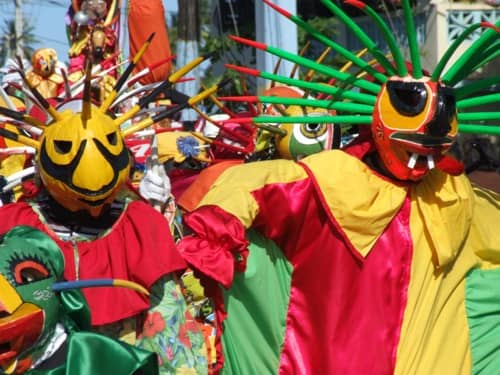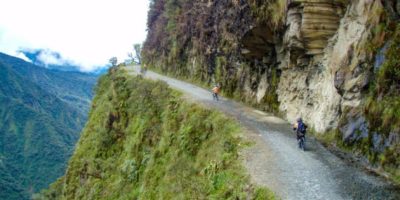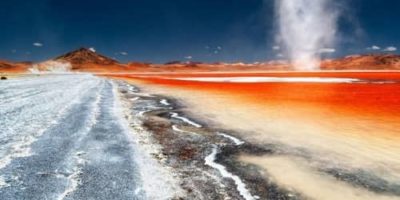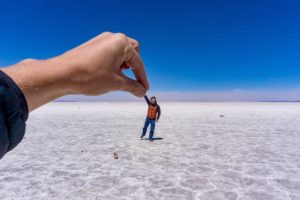If you’re traveling to Bolivia, you’re definitely going to visit Lake Titicaca. Is it better to go to Lake Titicaca during the peak season or is it better to go during the off-season and save some money?
What’s the best time to visit Lake Titicaca? The best time to visit Lake Titicaca are the months between April and December. You can enjoy bright, sunny days, and cold nights. Due to the high altitude, you can expect average temperatures between 5-15° Celsius.
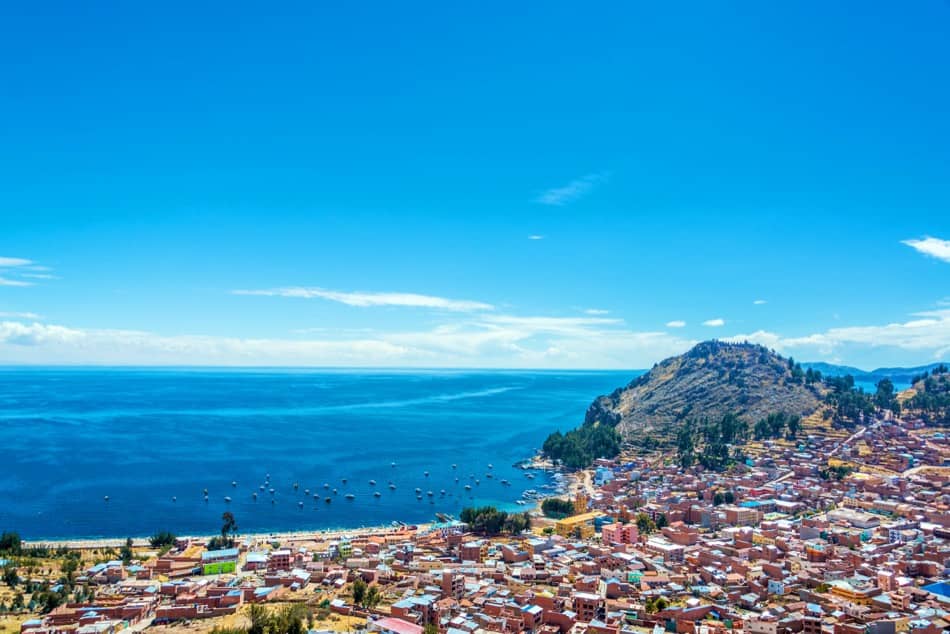
Below, you’ll find month by month information about the best months to visit Lake Titicaca. I’ll cover the weather and special festivals and events.
Contents
January
The weather in January at Lake Titicaca is humid (with approximately 100mm of rainfall). The average temperature is around 15°C during the day which drops to 5°C at night. The sun rises around 6AM and sets around 7PM.
Festivals & Events
Three Kings Day
The Catholic feast known as the “Epiphany of the Lord or worship of the Magi” is better known in Peru and its regions as “La bajada de Reyes”, “Pascua de Reyes” or “La visita de los Reyes”. This Catholic festivity evokes the three Wise Men Melchior, Gaspar and Balthazar, who traveled from the East to Bethlehem, guided by a star in order to honor and give offerings to the future King of the Jews called Jesus.
The people of Lake Titicaca and the surrounding areas celebrate their various religious festivals, and other customs, in a particular way that’s rooted in traditions that express deep feelings of faith. This of course is accompanied by much excitement, dance, music and color, as well as the flavors and aromas of typical and delicious dishes served on every table.
February
The weather in February at Lake Titicaca is humid (with approximately 110mm of rainfall). The average temperature is around 10°C during the day which sometimes drops below 0°C at night. The sun rises around 6:30AM and sets around 7PM.
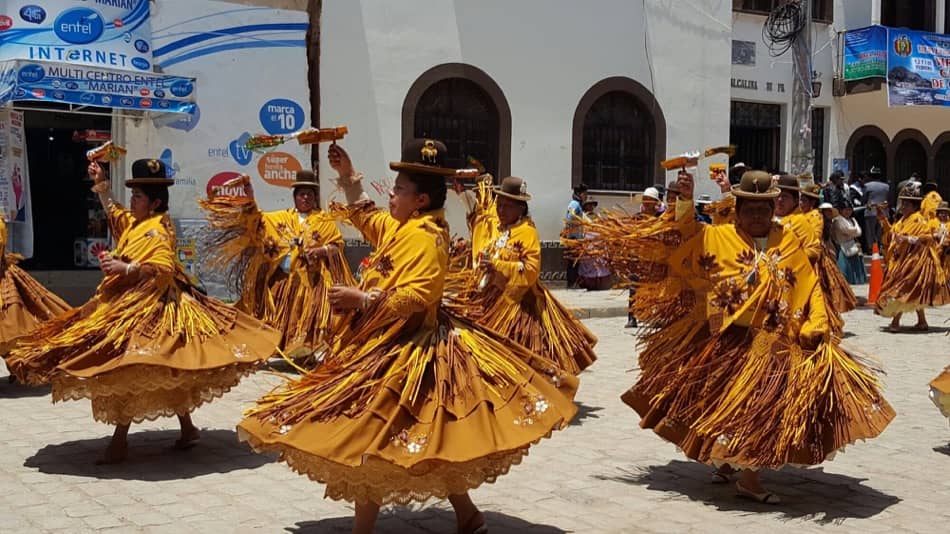
Festivals & Events
La Virgen de Candelaria
The festival of “La Candelaria” is celebrated every February 2nd, coinciding with the celebration of the presentation of the Lord and the ritual purification of the Virgin Mary. In the middle of the 5th century this celebration was known as the “Festival of Lights”. This festival is held 40 days after Christmas.
In the city of Copacabana, on the shores of Lake Titicaca, the image of the Virgin of Candelaria of Copacabana was carved by the Aymara Indian Francisco Tito Yupanqui in 1583,. The Temple of Copacabana is the second oldest temple in Latin America.
In Bolivia, the Virgin of Candelaria is the patron saint of Aquil (Cochabamba), Rurrenabaque (Beni), Samaipata (Santa Cruz), Azurduy (Chuquisaca) and the community of La Angostura in Tarija. The Basilica of Copacabana located in the Plaza 2 de Febrero was built in a Renaissance style in 1550 and rebuilt between 1610 and 1651. In this temple is the image of the Virgin of Candelaria.
March
The weather in March at Lake Titicaca is humid (with approximately 70mm of rainfall). The average temperature is around 10°C during the day and drops to around 2°C at night. The sun rises around 6:45AM and sets around 6:45PM.
Festivals & Events
Semana Santa
The festivity of the Holy Week in Lake Titicaca begins on Palm Sunday with the traditional blessing of the Palm trees, procession and celebration of the Eucharist in the Cathedral Basilica from 9 in the morning
The Archbishops of the cities surrounding the lake offer the Communion Mass in the Cathedral, starting at 8 am. Masses are celebrated every hour until 12 noon.
April
The weather in April at Lake Titicaca is quite dry (with approximately 40mm of rainfall). The average temperature is around 10°C during the day and drops to around 0°C at night. The sun rises around 6:45AM and sets around 6:30PM.
May
The weather in May at Lake Titicaca is quite dry with almost no rain. The average temperature is around 8°C during the day and drops to below 0°C at night. The sun rises around 6:50AM and sets around 6:15PM.
Festivals & Events
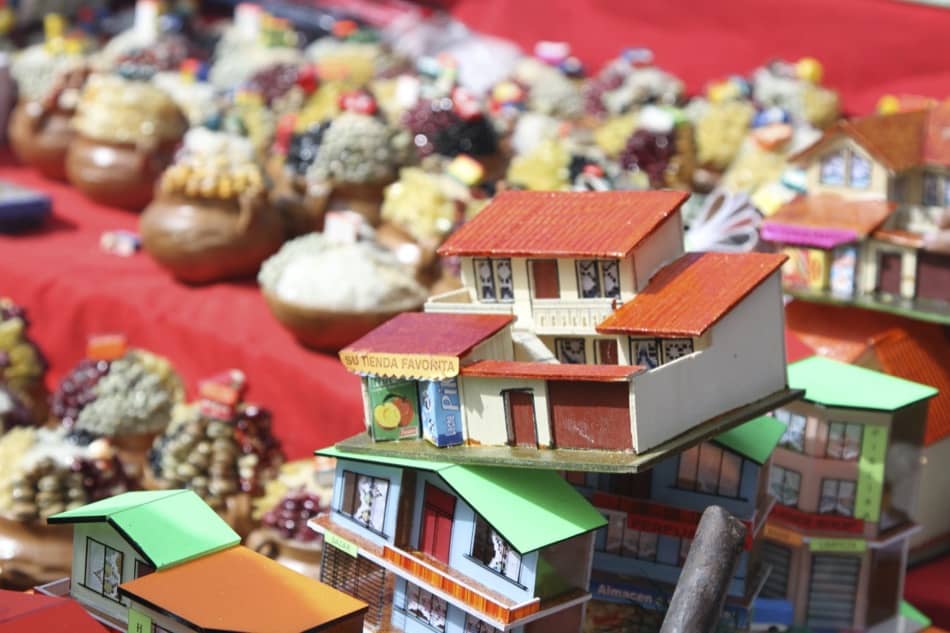
Fiesta de las Cruces Alasitas
In Latin America there is a traditional way of acquiring a “desire”. It sounds magical, but many people put their faith in it. These are the alasitas, which in Aymara means “buy me”, miniature figures that represent the materialization of desires and are associated with the agricultural and urban world as houses, cars, bills and much more.
The miniature objects are made by artisans from the highlands who, year after year, respond to the needs of the buyers to produce new “wishes”; from university degrees to passports. There are also symbols that represent wealth and abundance such as the “three-legged frog” or the Ekeko.
The Alasitas are considered a UNESCO Cultural Heritage in both Bolivia and Peru.
Fiesta de San Isidro Labrador
The festival of San Isidro Labrador is held in several communities around Lake Titicaca. The festival, which is celebrated in the month of May, lasts three days and is a tribute to the inhabitants of the countryside. San Isidro is considered a farmer, a worker of the land who strives to get good fruits, and who must be taken as an example, rather than worship.
The first day begins with a mass celebrated in Quechua and a nighttime verbena accompanied by traditional local bands and musical groups, with a great deal of participation by the inhabitants and visitors.
The second day is the celebration of the main mass, which once concluded, the parishioners take the saint out in a procession through the fields, where they proceed to the ll’ankada, which is a traditional representation of the plow of the land, in which the farmers carry their pairs of oxen adorned with multicolored flags, dramatizing a day’s work, accompanied by band musicians, in a participatory and popular festival atmosphere.
June
The weather in June at Lake Titicaca is quite dry with almost no rain. The average temperature is around 8°C during the day and drops to below 0°C at night. The sun rises around 7AM and sets around 6:15PM.
Festivals & Events
Año Nuevo Aymara
The festival, called “Willka Kuti” (Return of the Sun) or Machaq Mara (New Year), was born in the 1980s when young people from an Aymara Indian movement wanted to restore to the memory of their people supposedly age-old rituals dedicated every June 21 to the winter solstice in the southern hemisphere, in correspondence with a new agricultural cycle.
The commemoration became popular and in 2005, then President Carlos Mesa passed a law to declare the Aymara New Year as an Intangible, Historical and Cultural Heritage of Bolivia. In 2009, the government of Evo Morales decreed that every June 21 be a national holiday and then changed the name to Andean, Amazonian and Chaco New Year because the celebration reached more than 230 places in the country considered sacred.
Because of its symbolism, the festival is now replicated in some regions of Chile, Argentina and Peru, and Bolivians even reproduce it in Europe, although the archaeological center of Tiwanaku, 71 kilometers from La Paz, concentrates the main ceremonies because of its importance to the Andean indigenous world.
Fiesta de San Pedro y San Pablo
In the midst of religious fervor, the Catholic population of the cities around Lake Titicaca celebrate the feast of St. Peter and St. Paul which considered one of the most significant festivities for Catholic and Orthodox Christians.
This day is also considered the day of the fisherman, where the artisan fishermen of Lake Titicaca, come massively to the sacred place to ask for many blessings.
Without a doubt, it is one of the most important religious celebrations where the parishioners come en masse to worship the venerated image of San Pedro and San Pablo.
July
The weather in July at Lake Titicaca is dry with almost no rain. The average temperature is around 8°C during the day and drops to below 0°C at night. The sun rises around 7AM and sets around 6:30PM.
Festivals & Events

Fiesta de Santiago Apóstol
Although the main festival is on 25 July, the celebrations extend over several days before, during and after the onomastics. On those days, religious fervour is felt in the atmosphere although the cultural, fun and festive character takes on more and more strength.
The city’s cultural and leisure offer is centred on exhibitions and street performances. One of the highlights is the night of 24 July, the eve of the festival. Thousands of people gather at the city squares to watch the firework displays that are held.
August
The weather in August at Lake Titicaca is dry with almost no rain. The average temperature is around 7°C during the day and drops to below 0°C at night. The sun rises around 7AM and sets around 6:30PM.
September
The weather in September at Lake Titicaca is cold and dry with almost no rain. The average temperature is around 5°C during the day and drops to below 0°C at night. The sun rises around 6:30AM and sets around 6:30PM.
Festivals & Events
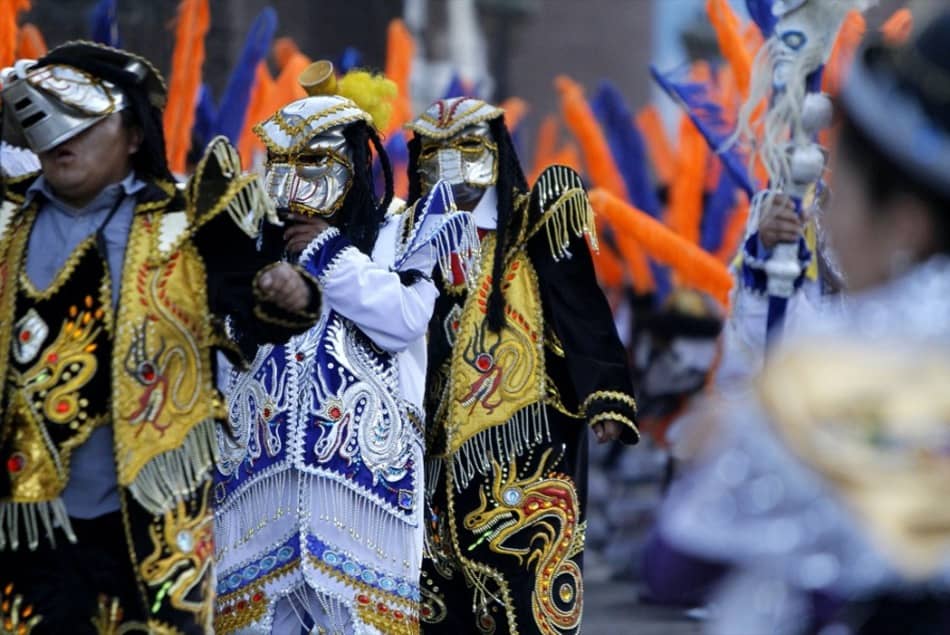
Fiesta de la Virgen de la Natividad
The celebration of the feast of the Nativity of the Blessed Virgin Mary is celebrated on September 8 and with this the Byzantine worship year opens, which closes with the Dormition in August.
Within the festive activities there are craft fairs, sports meetings, nights of retreat, popular dance and fireworks at the same time as the celebration of the novenas. Animals are usually sacrificed to prepare the exquisite dishes for the musicians, dancers and accompanists of each group.
On the central day, the solemn mass and procession of the venerated image of the Nativity takes place, who receives the homage of the alferados and their thousands of Peruvian and Bolivian devotees who arrive on these holidays from Lima, Tacna, Arequipa, La Paz, Santa Cruz, El Alto and other places.
Fiesta de la Virgen de las Mercedes
The title Mariano La Merced dates back to the foundation of the religious Order of Los Mercedarios on August 10, 1218, in Barcelona, Spain with Saint Peter Nolasco as its founder and Saint Ramon Nonato as its reformer.
The Virgin of Mercy awakens devotion and gratitude in many countries of America, where she was known, thanks to the miracles attributed to her: won battles, impossible triumphs and also the enlightenment of men who were key to the history of several nations.
To her, every September 24th, the Festivities of Our Lady of Mercy are dedicated, where traditional processions and celebrations take place. It is the one with the most patronage in Latin America.
October
The weather in October at Lake Titicaca is cold and dry with almost no rain. The average temperature is around 9°C during the day and drops to below 0°C at night. The sun rises around 6:10AM and sets around 6:30PM.
Festivals & Events
Fiesta de la Virgen del Rosario
The Fiesta de la Virgen del Rosario is a religious festival in which more than 40 fraternities and hundreds of parishioners show their devotion to the Mother of the Rosary.
The Rosary Festival is eminently Catholic, but has an unmistakable Andean character. The celebration takes place in a festive atmosphere in the open air, with the farce of the dancers dressed and masked as devils and brunettes, who are dancers disguised as lions, bear tigers and monkeys, and who perform a parade accompanied by band music, since for some years now the traditional Andean wind instruments, quena, siku and pinkillu, have been replaced by brass instruments.
The custom of using the Holy Rosary as a weapon of defense against evil dates back to the episode of the Battle of Lepanto. The Catholic troops dedicated the naval victory of Lepanto to the Virgin Mary, invoked during the battle, and Pope Pius V promoted October 7 as the Day of the Holy Rosary. The Spanish monarchy moved and promoted the figure of the Virgin of the Rosary as the local patron saint in its overseas possessions. The Marian cult has been practiced in Bolivia since the early years of the Colony, with the arrival of the Jesuits to Charcoal lands in 1577, when they settled in Potosi.
In the same way that the carnival or pujllay festival is a heritage of the Yampara farmers, the festival of the Virgin of the Rosary is a heritage of the people of Tarabuco. In fact, both festivals complement each other as milestones in the annual agricultural cycle in Quechua cosmology: the gathering of the harvest in March and the sowing in October.
November
The weather in November at Lake Titicaca is humid. The average temperature is around 10°C during the day and drops to 0°C at night. The sun rises around 6AM and sets around 7PM.
December
The weather in November at Lake Titicaca is humid (over 100 mm of rain). The average temperature is around 14°C during the day and drops to 0°C at night. The sun rises around 6AM and sets around 7PM.
Festivals & Events
Fiesta de la Inmaculada Concepción
The Day of the Immaculate Conception celebrates that Mary was born without original sin when she was conceived. This feast is one of the four major celebrations of Mary and is celebrated on December 8. However, the feast begins with the Mass on the 7th.
Mary is called by God to be the mother of his son and therefore a collaborator in the salvation of humanity by Christ. Like the Assumption of Mary, although this episode does not appear explicitly in the Gospels, tradition recognizes it as a consequence of the incarnation of the Son of God. A biblical fact that is revealed in the Archangel Gabriel’s statement Rejoice, full of grace, the Lord is with you (Luke 1:30).
Conclusion
When choosing your trip to Lake Titicaca, it’s best to visit during the winter months. Although any time is a good time when you’re visiting Lake Titicaca, there are a lot of interesting festivals between April and December that you shouldn’t miss. That said, no matter when you visit, you’ll have a great time.
